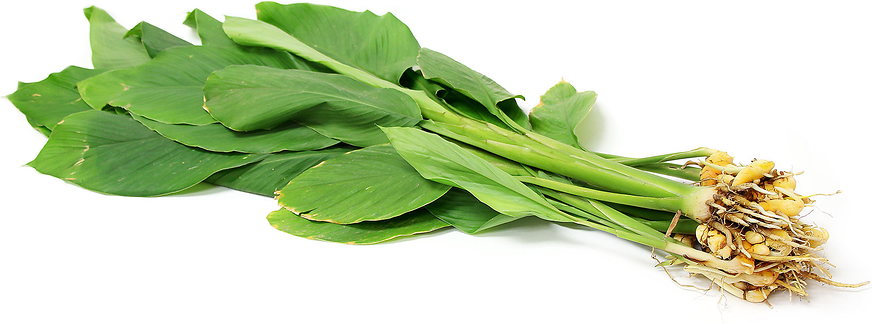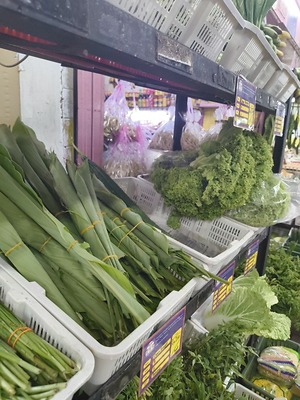


Turmeric Leaves
Estimated Inventory, lb : 0
Description/Taste
Turmeric leaves are the leaves that emerge from the rhizomes of the Turmeric plant. These leaves have a lanceolate shape that averages 46 centimeters to about a meter long and 30 to 48 centimeters wide. They have a vibrant grass-green hue and sprout from an erect, thick green stem that may turn purple-brown where it connects to the center of the leaves. Turmeric leaves have veins that extend out from this center stem in a diagonal pattern all the way up the leaf. They have a smooth, shiny texture with slightly curved edges and a central fold, frequently curling at the edges when they grow longer. When cut, Turmeric leaves release a distinctive spicy lemon scent that's reflected in their flavor. These leaves also possess a gingery, floral taste with a subtle bitterness, astringent undertones, and hints of mint and grass.
Seasons/Availability
Fresh Turmeric leaves are available from summer to fall, while dried Turmeric leaves are available year-round.
Current Facts
Turmeric leaves are botanically classified as Curcuma longa and belong to the Zingiberaceae family, which also includes cardamom and many varieties of ginger. These leaves are referred to as Curcuma leaves, Haldi leaves, Manjal leaves, Haldi ke Pette, and Daun Kunyit. They are predominantly produced in their native coastal regions of India. Turmeric plants are primarily known for their edible roots but all parts of the plant can be consumed including their flowers and leaves. They are perennial herbaceous plants that can grow over a meter tall and are valued both for the culinary uses of their roots and leaves as well as for the ornamental appeal of their pink and white tropical flowers.
Nutritional Value
Turmeric leaves have many cultural and medicinal uses that date back to ancient India. They are used in Ayurvedic medicine and are believed to have antiseptic properties that help reduce symptoms of colds, jaundice, and intestinal worms. Turmeric leaves are also believed to aid digestion and help prevent bloating and abdominal discomfort. They are known as a cooling herb that can be pounded and made into a paste to be topically applied for relieving swellings and sprains. This paste can also be used on the face as a cosmetic treatment to help soothe skin and remove blemishes.
Applications
Turmeric leaves can be eaten fresh, cooked, steamed, pickled, or dried. They may be incorporated into curries, soups, stews, stir-fries, ramen, rice wraps, and tamales or selected for making condiments like chutney and kimchi. In both India and Southeast Asia, Turmeric leaves are used as a wrapper for fish before frying or grilling. Indonesian and Thai cuisines often use Turmeric leaf parcels for steaming dishes, allowing the heat to enhance and impart their flavor onto the food. These leaves can also be ground or crushed to make a paste that's then fried into dried curry dishes like chicken or vegetarian rendang. Turmeric leaves pair well with lemongrass, makrut lime leaves, tamarind, chiles, garlic, onion, ginger, and coconut milk. Fresh leaves will keep up to a week when stored in the refrigerator. The dried leaves will keep for several months when stored in an airtight container and placed in a cool, dry, and dark place.
Ethnic/Cultural Info
Turmeric leaves are commonly incorporated into traditional Southern Asian cuisine. They are used in a recipe called Goan patoli, a popular dish enjoyed by the Mangalorean people of Southwestern India. This traditional stuffed flatbread uses ground rice paste and coconut to create a breading stuffed with ground cardamom and jaggery, a sweetener made from palm sap or dried sugar cane. This flatbread is steamed in Turmeric leaves and often enjoyed with breakfast or afternoon tea. Beef Rendang is an Indonesian and Malay entrée that also involves Turmeric leaves. This tender, aromatic dish slow-cooks buffalo meat in a spiced coconut gravy made with ginger, lemongrass, a root spice called galangal, and thinly sliced Turmeric leaves. Beef Rendang originated in the 15th century as a method for preserving tough buffalo meat. It is traditionally enjoyed at Malay weddings and was once carried on arduous journeys by nomads traveling from village to village in search of work.
Geography/History
Turmeric plants originated in Southeast Asia and India, where they have been used as a spice and medicine for around 4,000 years. They grow in tropical, subtropical, and coastal climates with a moderate amount of rainfall and temperatures between 20 and 30 degrees Celcius. Turmeric leaves and the plants they grow on are a domesticated species that’s frequently cultivated in home gardens and commercially. Turmeric is believed to have spread to China by the year 700 CE and later to Africa and Jamaica by the 18th century. Today, Turmeric leaves are found at specialty grocers and fresh markets in Asia, Northern Australia, Africa, Europe, South America, and the United States.
Recipe Ideas
Recipes that include Turmeric Leaves. One
| Just as Delish |
|
Beef Rendang Malaysian style |
| The Roasted Root |
|
Anti-Inflammatory Smoothie |

















